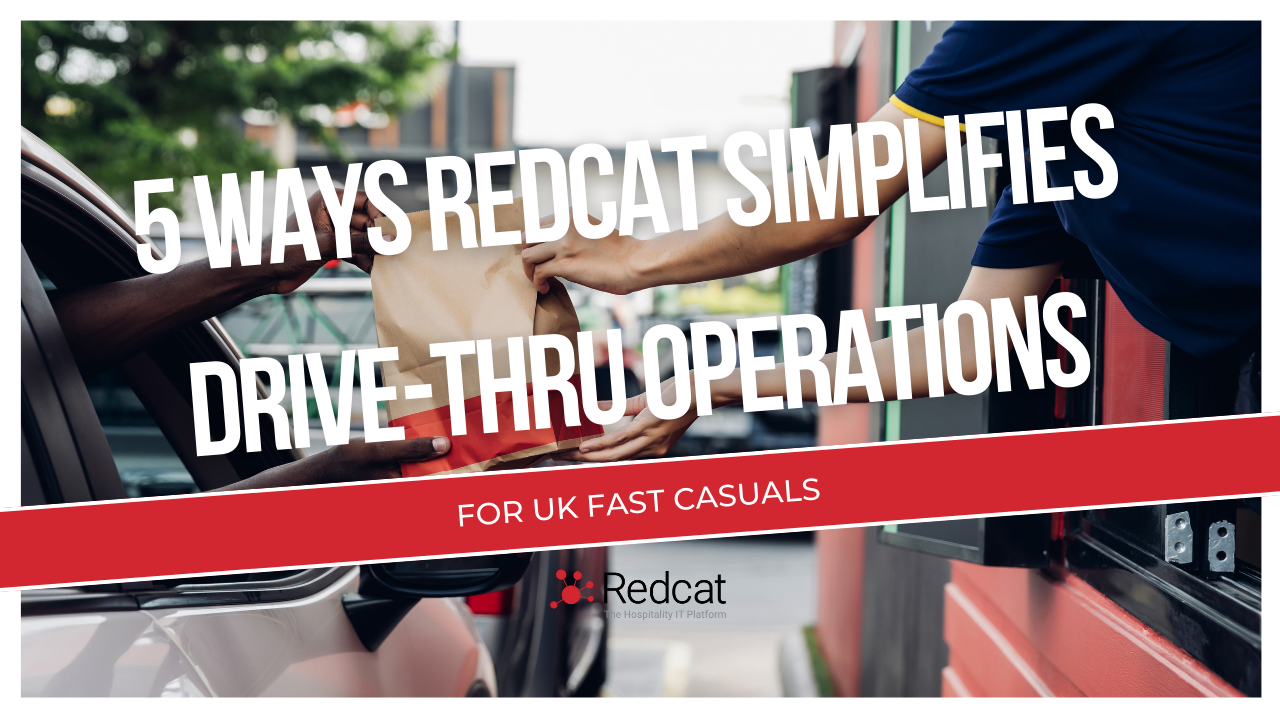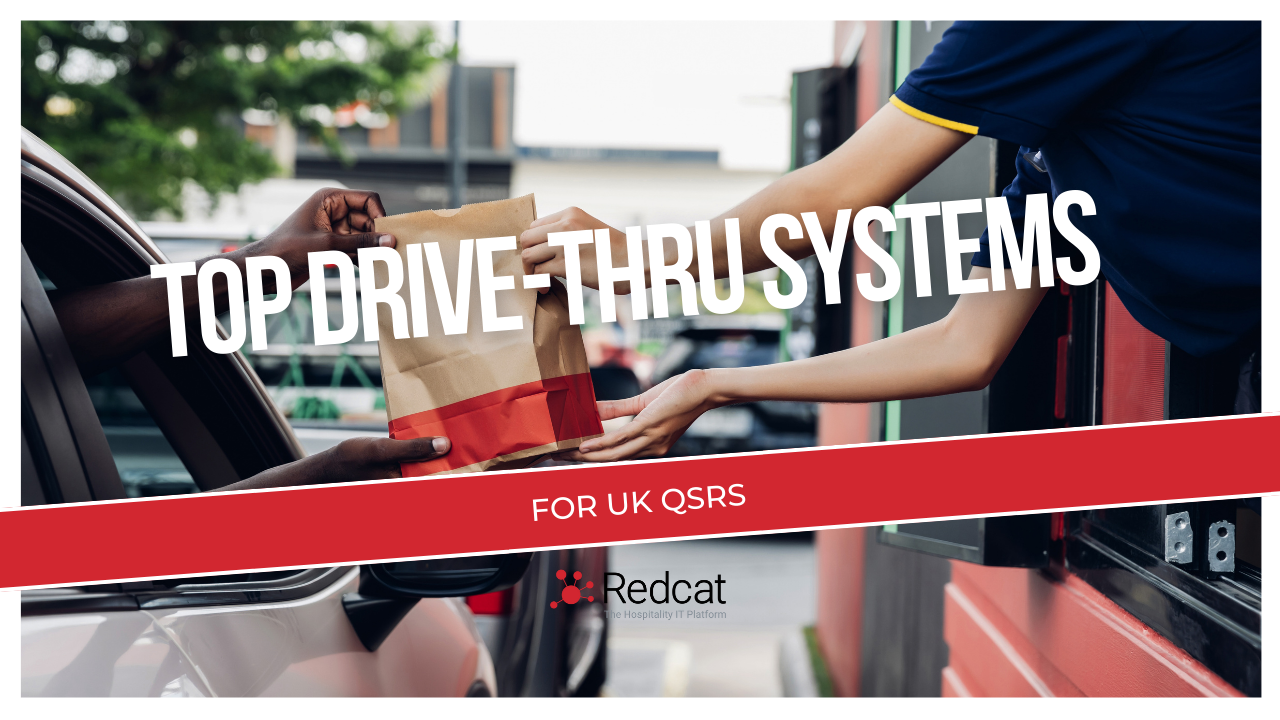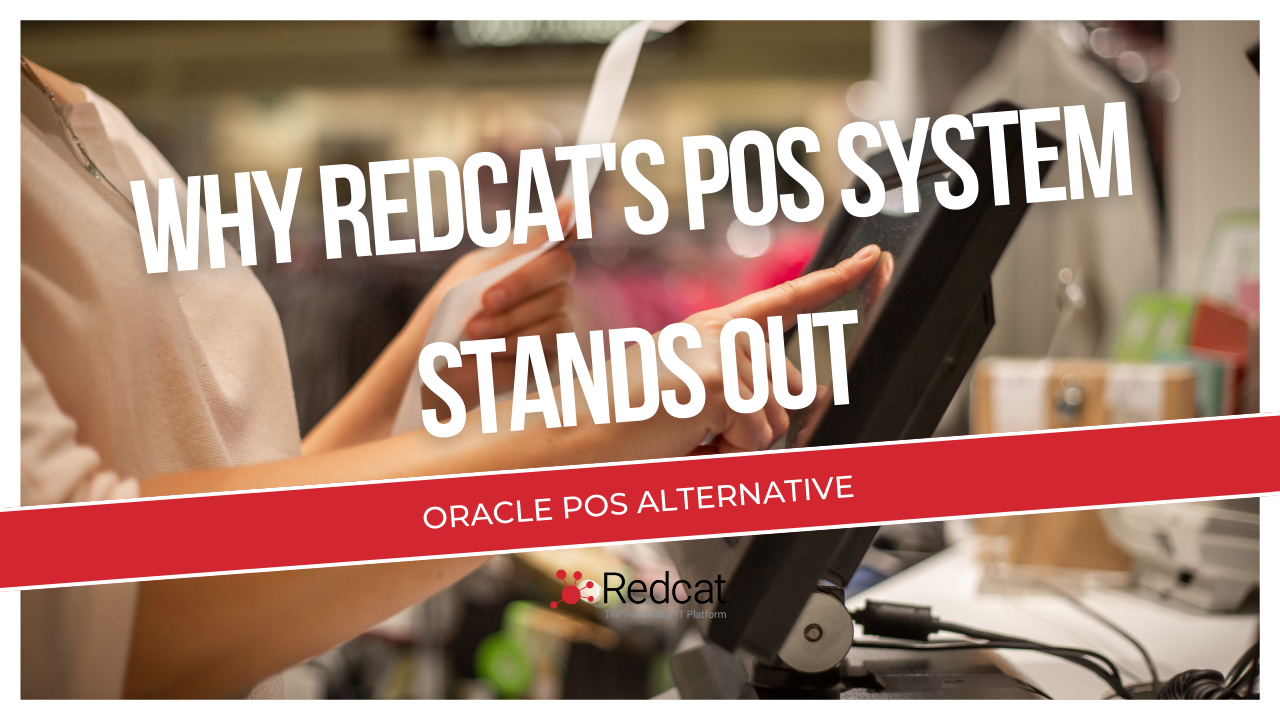5 Ways Redcat Simplifies Drive-Thru Operations for UK Fast Casuals
Introduction In the fast-paced world of fast casual dining, drive-thru operations have become indispensable.
13 min read
Louie Scarpari : Mar 12, 2025 8:14:29 PM

In today’s fast-paced world, convenience is paramount—and nothing epitomises convenience better than a drive-thru. For Quick Service Restaurants (QSRs), a well-designed and efficient drive-thru can significantly enhance customer satisfaction, drive sales, and improve operational efficiency.
However, to successfully set up a drive-thru, restaurants need more than just a serving window. The right drive-thru POS systems, efficient queue management, and staff training are essential for a seamless customer experience. For QSRs looking to stay competitive in QSR operations across the UK, having the right restaurant POS systems can make all the difference in delivering fast, frictionless service.
This is where Redcat POS comes in. With advanced drive-thru technology, Redcat’s solutions help restaurants streamline operations, improve throughput, and reduce wait times.
A reliable Drive-Thru POS system is the backbone of any successful drive-thru operation. The ability to process orders quickly, reduce errors, and integrate seamlessly with other restaurant systems is essential for maximising efficiency and ensuring customer satisfaction.
Redcat’s Drive-Thru POS system is specifically designed to streamline every aspect of order processing, ensuring speed, accuracy, and a seamless customer experience. From the moment a customer places their order to the moment they receive their meal, Redcat’s technology optimises each step, reducing wait times and minimising operational challenges.
A major challenge for drive-thrus is preventing congestion, especially during peak hours when orders can pile up quickly. Redcat’s Waiting Bay functionality ensures that customers with large or delayed orders do not hold up the queue. Instead of blocking the drive-thru lane, these customers can be directed to a designated waiting bay, where their food is prepared without disrupting the flow of other vehicles.
This queue management system improves overall efficiency by:
For high-volume QSRs, efficient queue management is crucial in maintaining a fast-paced operation while still delivering high-quality food and service.
Order mix-ups are one of the biggest frustrations for drive-thru customers. A wrong order can lead to customer complaints, wasted food, and lost revenue. Redcat’s licence plate identification system eliminates this issue by capturing vehicle registration details at the time of ordering.
This innovative technology ensures:
For multi-lane drive-thrus, this feature is especially useful in maintaining accuracy, ensuring customers in different lanes receive their orders without mix-ups.
Efficiency in the kitchen is just as important as efficiency at the order and pickup points. Redcat’s real-time production order system ensures that as soon as a customer places an order, it is immediately relayed to the kitchen staff.
This instant order processing helps:
By reducing the time between order placement and preparation, Redcat’s technology helps drive-thru restaurants serve more customers per hour, leading to higher revenue and improved customer satisfaction.
For a drive-thru to run smoothly, all systems need to communicate seamlessly—from the moment a customer arrives at the ordering station to the moment they drive away with their food.
Redcat’s Drive-Thru POS system ensures end-to-end integration by:
This comprehensive connectivity ensures that each step of the process—from taking the order to preparing and delivering it—is coordinated and efficient, helping drive-thru restaurants meet customer expectations for speed and accuracy.
The right POS system can make the difference between a frustrating, slow experience and a seamless, high-efficiency operation. With Redcat’s advanced drive-thru technology, businesses can ensure:
Investing in a high-performance Drive-Thru POS system is a crucial step for any restaurant looking to build a competitive and profitable drive-thru business.
The physical layout of a drive-thru is one of the most important factors in determining how smoothly operations run. A poorly designed layout can result in traffic congestion, long queues, delays, and frustrated customers. On the other hand, a well-optimised design ensures that vehicles flow smoothly through the ordering, payment, and pickup process, maximising throughput while maintaining a high standard of service.
When planning a drive-thru, restaurants must consider factors such as traffic flow, customer convenience, safety, and operational efficiency. A structured and intuitive layout reduces bottlenecks, improves order accuracy, and enhances the overall customer experience.
Ensuring that vehicles can enter and exit the drive-thru without confusion or disruption is fundamental to creating an efficient system.
By designing the entry and exit points strategically, restaurants can minimise wait times and ensure a steady, uninterrupted flow of vehicles.
The ordering station is where customers place their orders, and its design directly affects speed and accuracy.
With Redcat’s Drive-Thru POS system, the COD seamlessly integrates with the ordering system, ensuring real-time updates and accuracy. This feature helps reduce order errors, prevents disputes at the pickup window, and enhances customer confidence in the process.
Once customers have confirmed their orders, the next step is payment. A slow or inefficient payment process can create a bottleneck in the queue, reducing overall efficiency.
By streamlining the payment process, restaurants can increase throughput and reduce queue times, leading to a better customer experience.
The pickup window is where customers receive their orders, and accuracy at this stage is essential.
Licence plate recognition is particularly useful in multi-lane drive-thrus, where customers may not arrive at the pickup window in the exact order they placed their orders. This technology ensures that customers receive the right items, preventing confusion and frustration.
Even in the most efficient drive-thrus, some orders may take longer to prepare due to custom requests, larger orders, or complex meal combinations. Holding these customers in the main queue can cause delays for others.
By directing delayed orders to a separate waiting area, restaurants can maintain a steady and efficient flow of vehicles, ensuring that customers with simpler orders do not experience unnecessary delays.
A well-structured drive-thru layout significantly impacts a restaurant’s service speed, accuracy, and overall customer satisfaction. Proper planning ensures that vehicles move seamlessly from entry to exit, reducing congestion and improving operational efficiency.
By incorporating Redcat’s Drive-Thru solutions, restaurants can:
With a thoughtfully designed drive-thru layout, restaurants can provide a fast, convenient, and hassle-free experience, keeping customers satisfied and coming back for more.
Modern drive-thrus must integrate advanced technology to keep up with growing consumer expectations for speed, accuracy, and convenience. Traditional drive-thru setups that rely solely on manual processes can struggle to meet demand, leading to long wait times, order errors, and operational inefficiencies.
By incorporating cutting-edge solutions, restaurants can streamline operations, enhance the customer experience, and ultimately boost profitability. Redcat’s drive-thru technology offers innovative features that improve every aspect of the ordering process, from initial order placement to final pickup.
One of the most common frustrations in drive-thru service is incorrect orders, which can lead to customer dissatisfaction, refunds, and lost revenue. Order Confirmation Displays (CODs) provide a simple yet highly effective way to reduce order errors and improve accuracy.
With Redcat’s COD system:
By integrating CODs into the drive-thru setup, restaurants can minimise disputes and improve overall service efficiency.
As self-service technology becomes more popular, kiosk integration is emerging as a valuable addition to drive-thru operations.
Redcat’s kiosks enable:
By offering self-service kiosks, restaurants can enhance customer choice and flexibility, ultimately improving the drive-thru experience while reducing pressure on busy staff during peak hours.
Loyalty programmes are a proven way to increase customer retention and boost repeat visits. However, in many drive-thru settings, applying loyalty rewards can be a manual and time-consuming process, potentially slowing down service.
With Redcat’s integrated Loyalty Programme:
By integrating loyalty technology, businesses can increase engagement and provide a personalised experience that encourages customers to return.
To run an efficient drive-thru, restaurants need real-time insights into their operational performance. Redcat’s analytics tools provide valuable data that allows businesses to track key performance metrics and make data-driven improvements.
With Redcat’s real-time analytics, businesses can:
By using advanced analytics, restaurants can proactively optimise workflows, reduce inefficiencies, and make informed decisions that enhance overall drive-thru performance.
The integration of advanced drive-thru technology is no longer a luxury—it’s a necessity for modern QSR operations looking to stay competitive. With Redcat’s innovative solutions, restaurants can:
By leveraging the latest drive-thru technology, restaurants can provide a fast, seamless, and highly efficient service, ensuring a positive experience for every customer while maximising business profitability.
No matter how advanced the technology or drive-thru layout, the success of a drive-thru operation ultimately depends on the people running it. A well-trained team ensures smooth workflows, fast service, and excellent customer experiences. Without proper training, even the most efficient POS system and queue management tools can become bottlenecks instead of enablers.
Investing in staff training ensures that employees can:
The speed and accuracy of order processing directly impact customer satisfaction and revenue. Errors at the ordering stage can lead to long wait times, incorrect meals, and unhappy customers.
To ensure efficiency, staff should be trained to:
By training employees to use Redcat’s technology effectively, restaurants can maintain speed and accuracy, even during high-traffic periods.
Handling the lunch rush or evening traffic in a drive-thru requires strategic queue management and role efficiency. Without proper coordination, peak hours can lead to traffic jams, slow service, and frustrated customers.
Staff should be trained to:
By implementing structured peak-hour strategies, drive-thrus can maintain fast service even during the busiest times.
A fast drive-thru does not mean sacrificing customer service. In a high-pressure setting, staff must remain calm, professional, and friendly to provide a positive customer experience.
Training should focus on:
Customers appreciate courteous and well-trained staff, which can increase repeat business and boost a restaurant’s reputation.
A well-trained team is the backbone of an efficient drive-thru. By focusing on order accuracy, peak-hour management, and customer service, restaurants can maximise the benefits of Redcat’s drive-thru solutions while maintaining a smooth and enjoyable customer experience.
With a structured training programme, restaurants can:
By combining advanced technology with skilled employees, drive-thrus can achieve maximum efficiency and profitability, ensuring customers return time and time again.
Setting up a drive-thru is just the beginning—ongoing monitoring and optimisation are essential to maintain efficiency, enhance customer satisfaction, and increase revenue. A well-run drive-thru should evolve over time, adapting to customer demand, staff performance, and emerging technology.
With Redcat’s real-time analytics, restaurants can track key performance indicators (KPIs), identify bottlenecks, and make data-driven improvements. This ensures that service remains fast, accurate, and seamless, even during peak hours.
To measure and improve drive-thru operations, restaurants should monitor the following key metrics:
Customers expect quick service, and delays can lead to frustration, negative reviews, and lost business. Tracking order speed helps identify slow points in the workflow.
What to monitor:
How to improve:
A long drive-thru queue can discourage potential customers from joining, causing a loss in revenue. Monitoring queue times ensures that vehicles move through efficiently.
What to monitor:
How to improve:
Incorrect orders result in unhappy customers, costly remakes, and wasted ingredients. Tracking order accuracy helps identify where mistakes are happening.
What to monitor:
How to improve:
Happy customers return and recommend a restaurant to others, while negative experiences can harm reputation. Tracking customer satisfaction scores helps businesses understand where improvements are needed.
What to monitor:
How to improve:
By leveraging Redcat’s real-time analytics, restaurants can gain valuable insights into their operations, allowing them to identify problem areas and make timely adjustments to improve efficiency. This data-driven approach helps restaurants optimise their workflows, ensuring that staff members are deployed effectively based on the order volume and peak hours, thus improving service times and customer satisfaction.
Real-time analytics enable the introduction of new improvements, such as digital menus, which streamline the ordering process, faster payment options that enhance convenience, and drive-thru kiosks that increase throughput and reduce wait times. These insights can be used to enhance loyalty programmes, creating targeted promotions that encourage repeat business and strengthen customer relationships, ultimately driving growth and customer retention.
The best drive-thru operations don’t stay the same—they evolve. By constantly monitoring performance, implementing strategic improvements, and training staff on best practices, restaurants can ensure their drive-thru remains efficient, profitable, and customer-friendly. With Redcat’s technology and analytics, QSRs can refine every aspect of their drive-thru experience, keeping customers happy and operations running smoothly.
Setting up a drive-thru with Redcat is a smart move for Quick Service Restaurants looking to enhance convenience, boost sales, and streamline operations. By leveraging Redcat’s Drive-Thru POS solutions, restaurants can optimise throughput, reduce wait times, and provide a seamless customer experience. With the right drive-thru technology, efficient queue management, and staff training, a drive-thru can be a game changer in improving customer satisfaction and operational efficiency.
Ready to take your QSR to the next level? Contact us today to learn more about how Redcat can transform your drive-thru experience.

Introduction In the fast-paced world of fast casual dining, drive-thru operations have become indispensable.

The Growing Importance of Drive-Thru Technology in UK QSRs

In this article, we’ll explore the growing importance of advanced point-of-sale (POS) systems in the restaurant industry, with a particular focus on...